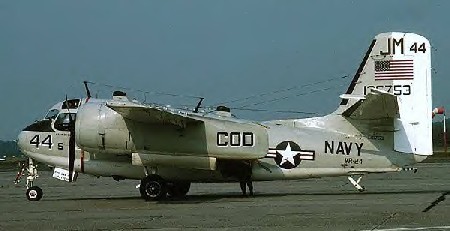To replace Avengers modified by the Navy as TBM-3R COD (Carrier Onboard Delivery) transports and used to fly personnel, mail, and/or small sized priority cargo to or from carriers, in 1950 Douglas proposed the AD-5 Skyraider fitted with either four passenger seats, ten bench-type seats, or four stretchers. Alternatively, the COD-configured AD-5 was to carry a maximum of 2,000 lbs of cargo. Although the Navy liked the multi-role capability of the AD-5 and order this Skyraider version into production, it was aware that the usefulness of the AD-5 in cargo configuration would be limited by its inability to carry often-needed bulky parts and spares such as aircraft engines.
To fill the need for a larger COD aircraft, in December of 1951 Grumman first contemplated using the S2F-1 airframe and then decided to base its proposal on the S2F-2 with a deeper, more capacious fuselage and enlarged tail surfaces. Wings and powerplants were to be identical to those of the ASW aircraft, all armament and electronic equipment removed, and the fuselage deepened further to provide a compartment with a clear length of 104 inches, a maximum width of 43 inches, and a maximum height of 52 inches. With a crew of two, the COD transport was to accomodate either nine passengers on rearward-facing seats or 3,500 lbs of cargo. Primarily intended as a carrier transport, Design 96 was also offered as an instrument trainer, multi-engined trainer, carrier qualification trainer, and utility or administrative aircraft. However, this proposal did not get the immediate attention of BuAer as the Navy then had more pressing needs and plans for the COD transport were temporarily shelved.
In 1953, when the Navy began showing serious interest in the proposed twin-engined COD transport, its specified that the aircraft would have to be able to carry internally large special stores for delivery to carriers. To that end, Grumman designed a bi-fold door on the port rear fuselage side. For passenger loading, only the rear panel swung outboard on two hinges on its forward edge; for oversize cargo loading, both pannels swung outboard on the five hinges of the forward panel. After the practicality of loading bulky nuclear weapons through the resulting 67-inch wide and 50-inch high opening was demonstrated with a fuselage mock-up, Grumman's efforts were rewarded with a contract for 45 transports, to be designated TF-1s.
With most of the airframe and the 1,525-hp Wright R-1820-82 radials being common with those of S2Fs, the Traders, as they were named, were to be built on the same line as the Trackers, and the 236th airframe on that line was selected to be completed as the first TF-1. First flown at Bethpage by Thomas "Boots" LeBoutillier on January 19, 1955, it was accepted by the Navy nine days later. A second Trader was delivered in April. Following abbreviated BIS trials the TF-1 was cleared for Service use in October, 1955.
Entering service in October 1955, TF-1s were assigned over the years to Fleet Tactical Support Squadrons, Fleet Logistics Support Carrier Onboard Delivery Squadrons, and directly to attack (CVAs) and anti-submarine warfare support CVSs) carriers.
Even though carrying special weapons to carriers at sea had been one of the TF-1 design requirements, in service Traders seldom did so. Conversely, the ability to deliver fully assembled jet engines, which was first accomplished by a TF-1 of VR-21 on June 26, 1959, when it flew from NAS North Island to deliver a Westinghouse J34 turbojet to the USS Yorktown 300 miles at sea, proved a welcome improvement over the more limited capablities of earlier COD aircraft. Moreover, for flying smaller-sized cargo, mail, and personnel to and from carriers, Traders proved well-suited and had a long and safe operational career. They proved particularly useful during the Vietnam War, whin in support of Task Force 77 in the Gulf of Tonkin, C-1As constantly shuttled between carriers and Cubi Point in the Philipines and Da Nang AB in South Vietnam.
Being the last carrier aircraft to operate on avgas and to require bridles for catapult launching (although they often made unassisted deck launches), Traders became increasingly difficult to support. In particular, when avgas was no longer stored aboard carriers, they could be used within close proximity to shore bases as their radius of action was limited to 425 miles when carrying their minimum load of 3,500 lbs. Accordingly, with the exception of the training carrier, all USN carriers lost their own CODs during the early 1980s, while the two Fleet Logistics Support Carrier Onboard Delivery Squadrons phased out their last C-1A in 1986. Finally, BuNo 146048, a C-1A assigned to the USS Lexington, became the last Navy piston-powered aircraft. Three days after last "trapping" on board the Lexington on September 27, 1988, it was delivered to the Naval Aviation Museum at NAS Pensacola.
In the electronic surveillance and training foles the TF-1Qs, first delivered to All-weather Attack Squadron 35 at San Diego on January 18, 1957, had a shorter career. Later on, with the ECM equipment removed, they were used as utility aircraft until the last were struck from the inventory in the mid-1980s.

Manufacturer: Grumman
Powerplant: (2) 1,525 horsepower Wright R-1820-82 radials
Wingspan: 69 ft 8 in (21.23 m)
Length: 42 ft (12.80 m)
Height: 16 ft, 4 in (4.97 m)
Wing area: 485 sq ft (45.06 sq m)
Empty weight: 16,631 lbs (7,544 kg)
Loaded weight: 23,031 lbs (10,447 kg)
Max. speed: 280 mph at 4,000 ft.
Cruising speed: 167 mph.
Climb rate: 1,950 ft/min
Service ceiling: 24,800 ft
Range: 1,110 miles (1,785 km)
